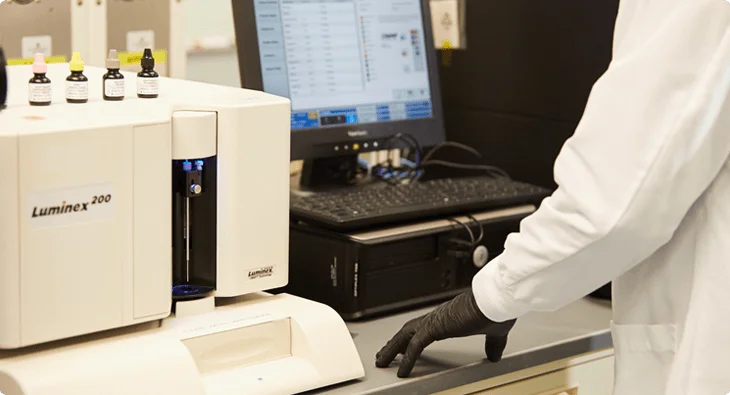Peer-Reviewed Publications Illustrate Versatility of xMAP® Technology
Applications go well beyond human samples, with demonstrated uses in animals, bacteria, and more
When the Luminex team first conceived the idea of the bead-based multiplexing that would lead to xMAP® Technology, they never imagined the broad range of applications it would one day enable. Decades later, we are constantly impressed by the creative uses scientists find for this versatile platform.
To celebrate the great diversity of xMAP-enabled applications in the research community, we’ve pulled together a sampling of recent publications showing how this technology is being used beyond human health needs. From animals to viruses and more, here’s a look at the utility of bead-based multiplexing in a variety of applications.
[thumbnail]
Evaluation of serum MMP-2 and MMP-3, synovial fluid IL-8, MCP-1, and KC concentrations as biomarkers of stifle osteoarthritis associated with naturally occurring cranial cruciate ligament rupture in dogs
Journal: PLoS One
First author: Sarah Malek
Project summary: Scientists aimed to identify a biomarker signature associated with inflammation in dogs with stifle osteoarthritis, a progressive degenerative canine disease.
How xMAP made a difference: xMAP Technology was used to analyze serum and synovial fluid samples collected from 62 affected and 50 healthy dogs. The team found a biomarker signature strongly linked to inflammation among dogs with the disease.
Detection of specific Atlantic salmon antibodies against salmonid alphavirus using a bead-based immunoassay
Journal: Fish & Shellfish Immunology
First author: Lena Hammerlund
Project summary: Scientists aimed to develop a reliable serological assay to detect antibodies indicative of salmonid alphavirus, a cause of pancreas disease in Atlantic salmon and a major threat for the aquaculture industry in Europe.
How xMAP made a difference: xMAP Technology enabled scientists to design a bead-based immunoassay that takes less time than a virus neutralization assay and can be used on live fish due to the small sample volume required. Results were highly correlated with those from the neutralization assay.
Detection of Babesia, Borrelia, Anaplasma, and Rickettsia spp. in Adult Black-Legged Ticks (Ixodes scapularis) from Pennsylvania, United States, with a Luminex Multiplex Bead Assay
Journal: Vector-Borne and Zoonotic Diseases
First author: Julia Livengood
Project summary: Scientists aimed to detect the presence of a range of microorganisms harbored by the black-legged tick, Ixodes scapularis, in a Pennsylvania study.
How xMAP made a difference: The team used an xMAP-based assay to identify 20 pathogens in an analysis of nearly 300 tick samples.
Establishment and application of a 10-plex liquid bead array for the simultaneous rapid detection of animal species
Journal: Journal of the Science of Food and Agriculture
First author: Mingzhu Mei
Project summary: Researchers aimed to address the growing challenge of meat fraud and adulteration, problems that are on the rise in regions around the world.
How xMAP made a difference: The research team developed a multiplex xMAP assay to detect 10 different types of animals in just three hours, and then validated the assay by testing it on DNA extracts from meat products as well as animal feed. Results showed excellent concordance with conventional testing methods.
Bio-Plex suspension array immuno-detection of Listeria monocytogenes from cantaloupe and packaged salad using virulence protein inducing activated charcoal enrichment media
Journal: Food Microbiology
First author: J.B. Day
Project summary: Scientists aimed to improve the testing process for detecting the Listeria monocytogenes pathogen in food samples, such as salad greens and cantaloupe.
How xMAP made a difference: Scientists selected a different type of enrichment media and deployed an xMAP-based assay to detect even small traces of the pathogen, with results generated in one day.
Establishment and optimization of a liquid bead array for the simultaneous detection of ten insect-borne pathogens
Journal: Parasites & Vectors
First author: Hui-yu Wang
Project summary: Insect-borne pathogens are a major public health issue, with notorious examples such as Ebola virus and West Nile fever virus. In this study, scientists focused on developing a multiplex assay to detect 10 of these pathogens.
How xMAP made a difference: Researchers chose xMAP as their platform, creating a 10-plex assay and testing 3,000 clinical samples for validation. Detection of all pathogens was highly sensitive, specific, and reproducible, with positive results seen for as few as 10 copies of the target gene.

